Starting a small business is one of the most exciting — and overwhelming — decisions you can make. You’ve got ideas. Maybe you’ve spotted a gap in the market, or you’re itching to do something on your own terms.
But then reality hits: where do you start?
You’re not alone in asking that. Millions of people launch businesses every year, but not all of them succeed. In fact, roughly half of small businesses close within five years. So what’s the difference between those who make it and those who don’t? Planning, persistence, and knowing what matters most early on.
This guide will walk you through it, one step at a time. Read about the essentials, real-life examples, and a few shortcuts to help you start strong.
Starting a small business – step-by-step guide

Step 1: Refine your business idea and validate demand
Before you jump into paperwork, branding, or websites, step back and ask yourself one question:
Is there real demand for this?
A good business idea solves a specific problem for a specific group of people. It doesn’t need to be revolutionary, just useful and needed.
Start with this mini-checklist:
- What problem are you solving?
- Who has this problem — and how do they currently deal with it?
- Why are you (or your solution) different or better?
Let’s say you want to sell handmade soaps. That’s great, but who exactly are you selling to? Eco-conscious shoppers? People with sensitive skin? Boutique hotel owners? The clearer you are, the easier it is to market and sell later.
How to validate your idea (without spending money):
- Ask people in your target audience what they’re struggling with.
- Search on Reddit or Quora to see how people talk about the problem. On Reddit, search for phrases your customers might use, like “best thrift stores in Manhattan” or “affordable graphic designer for small businesses”. Threads like this reveal what people are really looking for and what’s missing. Look for repeated complaints, wishlist-style posts, or specific unmet needs, these are gold for shaping your offer.

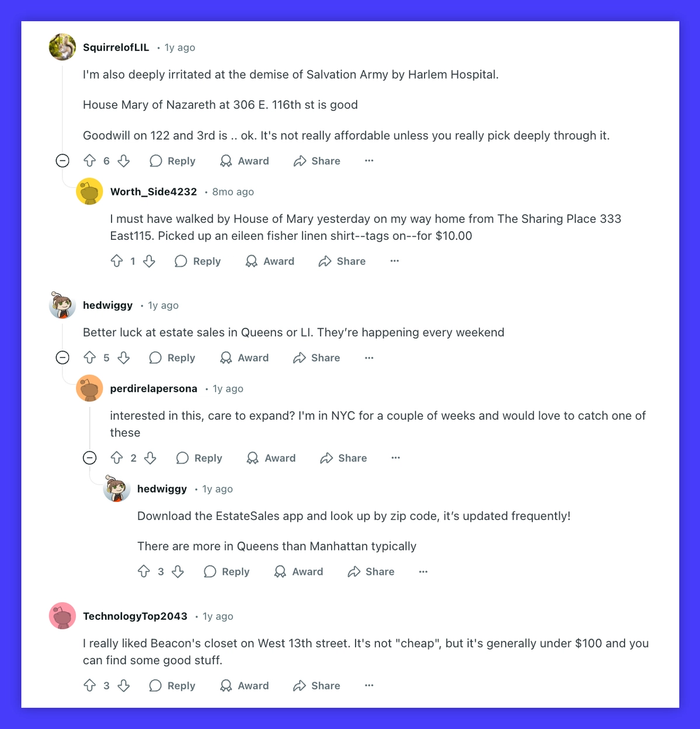
- Use Google Trends or a tool like AnswerThePublic to see what people are searching for. For example, if you sell necklaces, these topics are what you might want to cover:

- Look at competitors — what are their strengths? Weaknesses? Can you spot a gap?
A couple of honest conversations now can save you months of wasted time later.
Step 2: Write a simple business plan
Business plans sound formal, but yours doesn’t have to be. A one or two-page outline is plenty to get started.
The goal here isn’t to impress a bank. It’s to give yourself clarity.
Here’s a basic structure that works:
- Summary – What are you building?
- Problem – What’s the customer pain point?
- Solution – What do you offer to solve it?
- Target audience – Who are your customers?
- Marketing plan – How will they find you?
- Money plan – What will it cost to start? How will you earn?
- Timeline – What will you do this month? This quarter?
Let’s bring this to life.
Imagine: “I help local yoga studios stand out with custom design and branding packages. I’ll reach them through direct outreach and referrals, charging $500–$1,500 per package. I’ll start with 3 clients and grow from there.”
That’s a plan. Clear, focused, and grounded.
Get our small business plan template here.
Step 3: Choose your business name and legal structure
This step can feel oddly high-pressure, but it doesn’t have to be.
> Picking a name:
Choose something:
- Simple to say and spell
- Relevant to your offer or audience
- With an available domain and social handles
Use tools like Namechk, GoDaddy, or Namecheckr to check what’s available. Chances are that .com domains will be taken, but there are plenty of others for you to choose from! Then do a quick trademark search via USPTO.gov.
Pro tip: You don’t need a fancy brand agency. Many successful businesses started with simple names and refined them later.
> Choosing a business structure:
This affects your taxes, liability, and how you operate.
Here’s a quick guide:
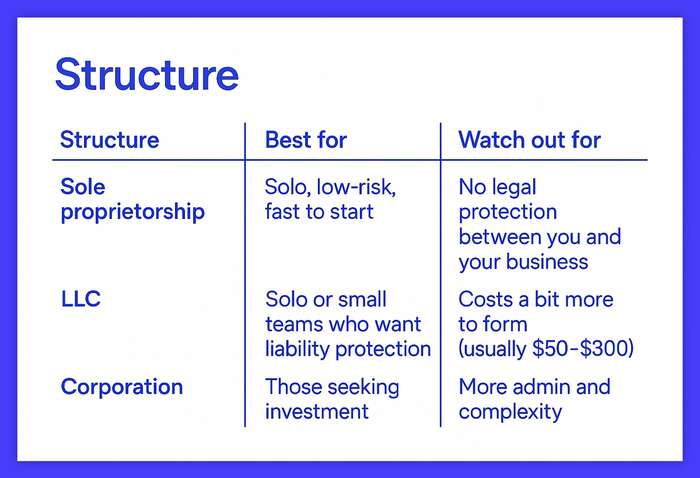
In most cases, new solo founders go with an LLC. It’s flexible, offers legal separation, and is easy to set up in most states online.
Step 4: Register your business and handle the paperwork
Once your name and structure are picked, it’s time to make it official.
Your registration checklist:
- Register your business with your state’s agency (usually the Secretary of State)
- Apply for an EIN (free on IRS.gov) — think of it like a Social Security number for your business
- Get the right licenses or permits depending on your industry and location (e.g. food handling, reseller’s permit, general business license)
- Open a business bank account to keep your finances clean and separate
If your city requires zoning or home business permits, look those up too. Local Small Business Development Centers (SBDCs) can often help you check requirements for free.
This step can seem time-consuming, but it’s essential for making your business official.
Step 5: Get your finances in order
Money is a common reason businesses fail — not just lack of it, but lack of clarity around it.
#1 Estimate your startup costs
Make a list of everything you’ll need before you can open your doors:
- Website and hosting
- Logo or branding materials
- Initial inventory or supplies
- Marketing materials or ad spend
- Tools or software
- Any legal or filing fees
Then sort these into:
- One-time costs (e.g., logo, LLC fee)
- Monthly expenses (e.g., subscriptions, rent)
Even if you’re bootstrapping, it helps to know your numbers.
#2 Explore funding options
You don’t need to go all-in on outside funding. Here are typical options:
- Personal savings (most common for those starting solo!)
- Friends and family (with clear expectations)
- Crowdfunding (like Kickstarter)
- Microloans or SBA-backed loans
- Start Up Loans UK – government-backed loans up to £25,000 with mentoring support
- Local grants – some boroughs or business hubs offer startup grants (check with your local council or British Library’s Business & IP Centre)
For many, starting small and reinvesting profits is the safest way to grow.
Let’s break down what a business – in this case, a consulting startup – might actually cost in the UK:
✅ One-time costs:
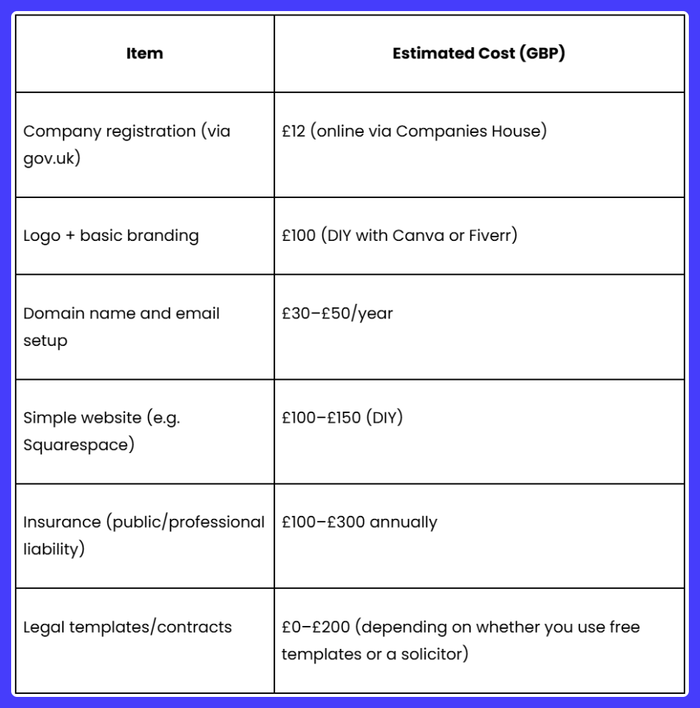
Estimated one-time total: £350–£800
📅 Monthly costs:
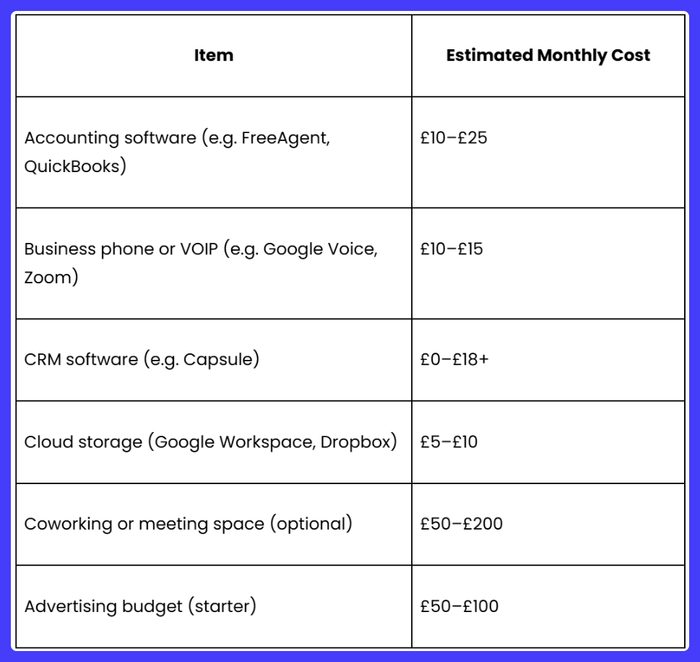
Capsule has a free plan!
Estimated monthly total: £75–£350
Summary:
If you start lean and smart, a London consulting agency can get off the ground for under £1,000, and run for £100–£200/month in the beginning. No inventory oro office needed, just you, your expertise, and a few smart tools.
Step 6: Set up your operations
Think of operations as “how your business runs behind the scenes.” You want to have just enough structure to stay focused, but not so much that you overcomplicate things.
A few core questions:
- Where will you work? (Home office, shared space, on-the-go?)
- What tools will you need to deliver your product/service?
- How will you handle scheduling, invoicing, and customer interactions?
- Do you need help — or can you start solo?
Even if you’re a one-person show, it’s worth thinking about tools early on.
Example:
- Use Google Calendar or Calendly to schedule
- Use Wave or QuickBooks for invoicing
- Use Capsule CRM to track contacts, follow-ups, and leads
CRM might sound “too soon,” but staying organized from day one helps you deliver better service — and close more deals — without dropping the ball.
Step 7: Start marketing — even if you’re not “ready”
You don’t need a full brand kit to start talking about your business. You just need to be clear, consistent, and find the right people. Here's how:
Set up a Google Business Profile
This helps you show up in local search results, especially valuable if you plan to work with nearby clients. Even if you don’t have a physical office, you can set it up using a service area.
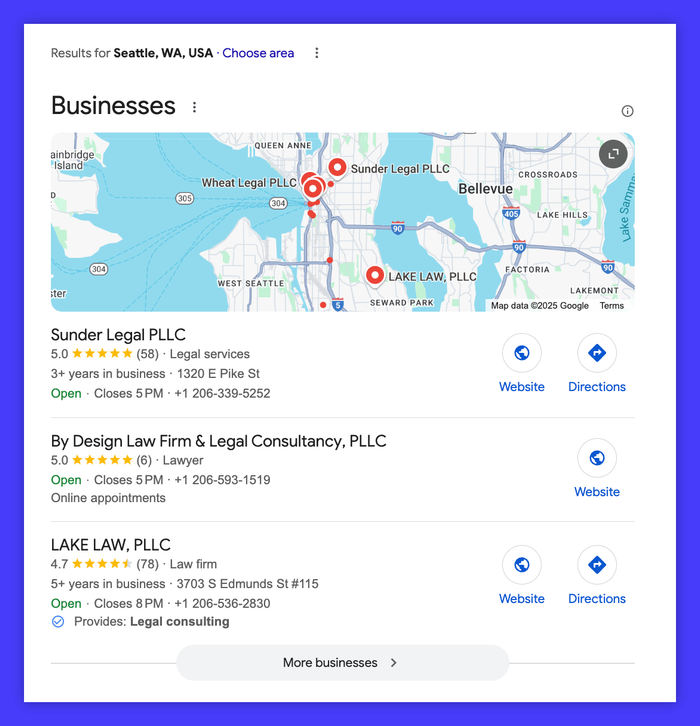
Tip: Add a simple description (“Legal consultant specializing in online business compliance.”), upload a headshot, and turn on messaging. It makes your business feel real, even if it’s day one.
Create simple social media profiles
Start by picking the platform your ideal clients are most active on. You don’t need to be everywhere — just somewhere consistent.
- Instagram → best if you’re visual, lifestyle-oriented, or working with creatives, beauty, fashion, or local service businesses. Great for showing process, behind-the-scenes, or before/after results.
- LinkedIn → perfect for B2B consultants, strategists, coaches, or anyone targeting founders, CEOs, startups, or agencies. Use it to share insights, mini case studies, and thoughtful posts about your industry.
- TikTok → growing fast for small businesses in creative or education-based niches. If your audience is younger, or if your work can be explained visually (design tips, marketing hacks, consulting myths), short-form video works incredibly well. It’s less polished, more relatable — and the organic reach is still strong. Look how Erika Kullberg, a money lawyer from the US, does it on her TikTok:

Tip: Start simple — one platform, one pinned post explaining who you help, what you do, and how people can reach you. That’s enough for week one.
Keep your bio clear and benefit-led. Example: 🧠 “Legal consultant specializing in brand protection and compliance strategy for small and medium businesses.”
You don’t need to post daily — just make your presence visible and clear.
Share your offer on your personal accounts — tell your story
This can feel vulnerable, but it works. People in your network already know, like, and trust you. Let them know what you’re building — and who it’s for.
Example post:
“Big news: I’ve officially started my own design studio ✨ I help service-based business owners stand out online with bold, strategic branding. If you know anyone launching something exciting — I’d love an intro! 🙌”
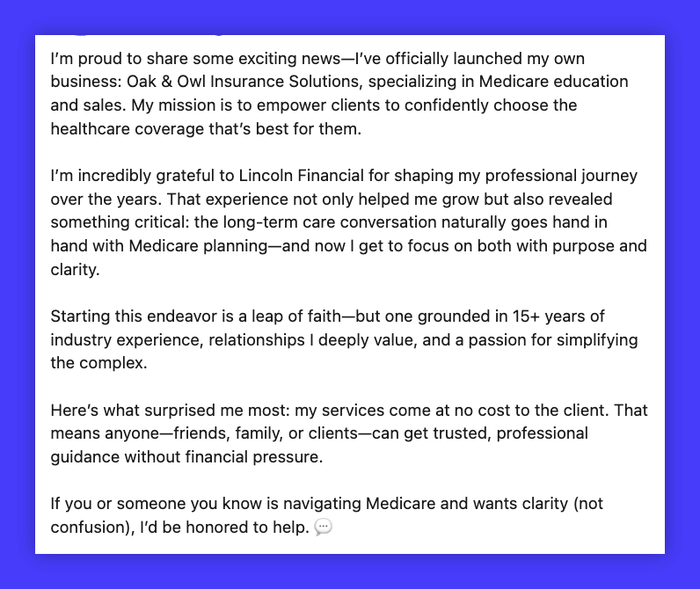
Why this works: It's not salesy. It’s story-led, clear about what you do, and makes it easy for others to refer you.
Reach out directly to 10 people
These can be:
- Past colleagues
- Business owners you admire
- Friends who might know someone
The key is to be helpful, not pushy.
Sample DM:
“Hey! I just launched a small creative studio and I’m doing a few branding audits for free to get early feedback. Would you (or anyone you know) be up for one? No pressure at all — just practicing and learning.”
This gets conversations started — and often leads to your first client, or at least some valuable insight.
Join 2 communities where your audience already hangs out
This is one of the fastest ways to understand what your market actually cares about.
For example, if you're running a creative agency, try:
- Facebook groups for startup founders or female entrepreneurs (e.g. “Female Founders Lounge” or “UK Startup Community”)
- Slack and Discord groups – you can find a great directory of Slack groups at https://slofile.com/
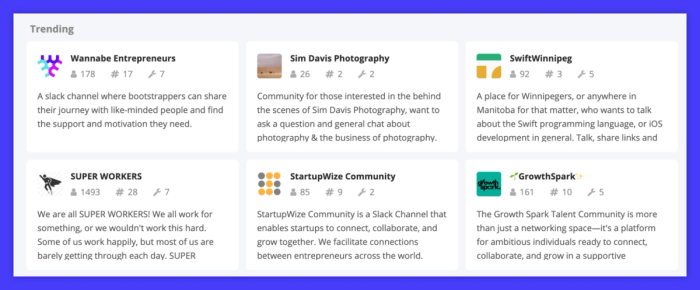
- Local small biz networks in your borough or city (check Meetup.com or Eventbrite)
Once you join:
- Don’t pitch. Instead, answer questions, give feedback, and share helpful tips.
- Comment on others’ posts with insight. That builds trust.
- Post something helpful: “Just created a 1-page brand checklist for early-stage founders — happy to share it if helpful!”
When people start commenting or DMing you, that’s your cue to go deeper — ask about their projects, offer ideas, and build the relationship.

Marketing at the beginning is more about relationships than reach. Don't stress about ads yet — start with trust.
Step 8: Launch, learn, and adjust
The perfect time will never come. So take the leap and get started - even if your inital output is messy.
Your launch could be:
- A soft launch to a few people in your network
- A beta round where you offer your service at a discount
- A public announcement with a free offer
Track what happens next:
- Who visits your site?
- Who reaches out?
- What questions do they ask?
Capture all of this. Use a CRM or even a Google Sheet to log leads and feedback. Every message is market research. Every “no” is an opportunity to tweak.
🎯 From idea to income: Sarah’s startup journey
Meet Sarah. She’s a graphic designer who wanted to offer branding packages for small businesses.
- She validated her idea by asking entrepreneurs in Facebook groups if they struggled with branding. Over 80 people said yes.
- She wrote a one-page plan outlining her services and pricing.
- Sarah chose the name “Brightline Studio,” grabbed the domain, and filed an LLC.
- With $500 in savings, she built a basic site and used Canva for mockups.
- Her first client came from a referral. Then another. She used Capsule CRM to track who she’d spoken to and followed up weekly.
- Within six months, Sarah had booked five clients — all managed with clear steps, a simple plan, and consistent action.
How Capsule CRM fits into your small business journey
Starting a small business means juggling a lot at once, including conversations, sales, follow-ups, admin, and marketing. And without a system in place, it’s easy to lose track of who’s interested, who’s paid, and who’s waiting for a reply.
That’s where Capsule comes in.
Capsule is the best CRM for small businesses, built to help you do more with less. It keeps your contacts, emails, tasks, sales pipeline, and follow-ups all in one clean, easy-to-use platform — so you’re instantly more organized, without adding extra work to your day.
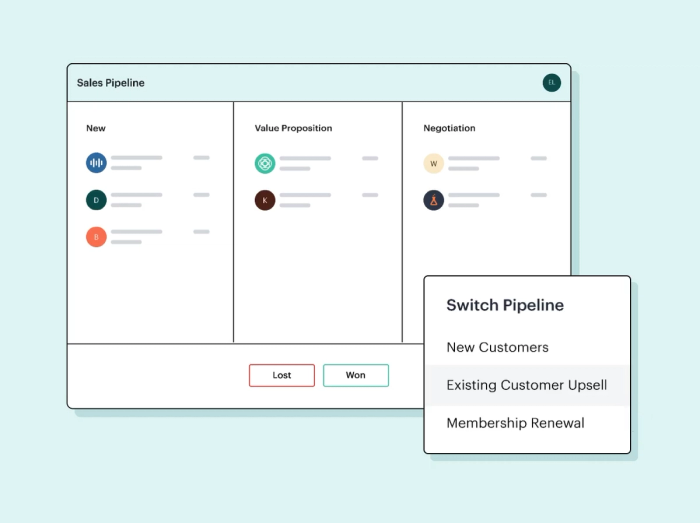
From chaos to clarity — instantly
You can import contacts from spreadsheets or Gmail and see everything related to that person — emails, notes, tags, sales opportunities — in one view. No more scattered docs, sticky notes, or missed messages. Just clarity.
“Easy to use and navigate; enough information but not overloaded with more than I need.” — Shelly Turner, Account Manager, The Crop Shop LLC
Build your sales pipeline without spreadsheets
With Capsule, you can track every deal and client conversation in a sales pipeline that mirrors your process. Want a reminder to follow up 3 days after a call? Capsule does that. Want to see where each client is in your funnel? Done.
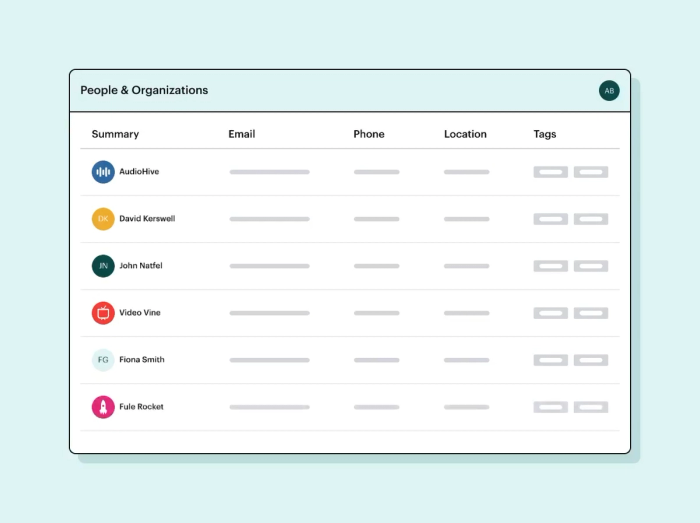
You can even spot patterns — which products close fastest, which clients go quiet, and what actions lead to revenue.
Better customer relationships from day one
Capsule helps you keep track of every client interaction so nothing slips through the cracks — whether it’s a new inquiry, a loyal customer, or a vendor. Capsule integrates with your existing tools (like Gmail, Outlook, Mailchimp, Xero) and brings everything into one central hub.

The result? You can respond faster, stay more personal, and deliver top-tier service — even as you grow.
Work from anywhere
With the Capsule mobile app, you can add notes after a client meeting, check your pipeline on the go, or follow up after a networking event — all without waiting until you're back at your desk. It’s built for small business owners who move fast.
Rated 4.7 on G2 and trusted by thousands of small businesses worldwide, Capsule CRM is your behind-the-scenes partner from the very first client to your 500th. You can try it free — no card required — and see how it fits your way of working.
Capsule also offers:
- Free and affordable pricing plans
- Seamless integrations with tools you already use
- Partner programs if you’re working with or advising other businesses
👉 Ready to get organized, stay on top of sales, and deepen your customer relationships?
Final thoughts
Starting a business can feel like standing at the bottom of a mountain. But you don’t need to climb it all today. You just need to take the next step.
This guide gave you a roadmap. The rest is action.
And when you're ready to organize customer conversations, follow-ups, or leads — Capsule CRM is here to grow with you. No pressure. Just help, when you need it.
You've got this. Let’s build something great.
FAQ
It varies. A service-based business might launch with $300–$500. A product-based business could need several thousand. Create a budget before spending anything — you can always start small.
Absolutely. Many businesses start as side hustles. Block out consistent time each week, avoid burnout, and use tools to stay organized.
Yes. It’s not for investors — it’s for you. A plan helps you focus and make better decisions.
As soon as you’re talking to potential customers. It’s hard to remember every detail. A simple CRM keeps things from slipping through the cracks.
Talk to people. Ask them what they need, what frustrates them, what they’d pay for. You’ll come away with clarity — and maybe even your first customer.




